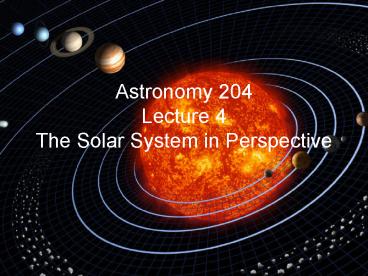Astronomy 204 Lecture 4 The Solar System in Perspective - PowerPoint PPT Presentation
1 / 16
Title:
Astronomy 204 Lecture 4 The Solar System in Perspective
Description:
Our Solar system is disk-shaped and all planets have a common direction of revolution. ... What is a Planet? A celestial body that is orbit around the Sun ... – PowerPoint PPT presentation
Number of Views:36
Avg rating:3.0/5.0
Title: Astronomy 204 Lecture 4 The Solar System in Perspective
1
Astronomy 204Lecture 4The Solar System in
Perspective
2
Lecture Outline
- Solar System Overview
- Planet motions
- Planet interiors
- Planet surfaces
- Planetary Atmospheres
3
Our Solar system is disk-shaped and all planets
have a common direction of revolution.
4
Observing the Solar Plane
An observer looking west just after sunset can
easily observer the disk-shaped nature of the
solar system through the positions of the
planets.
5
What is a Planet?
- A celestial body that is orbit around the Sun
- Has enough mass/self-gravity to make itself into
a round or mostly round shape - Has cleared the neighborhood around its orbit
6
And the other stuff?
- Dwarf Planet
- meets requirements of planet except it hasnt
cleared its neighborhood - Include Pluto and Ceres
- Small Solar System body
- All other stuff that isnt a moon
7
Most planets in our solar system have a common
direction of rotation.
8
Orbits of the Planets are very close to being
circular and there are two Scales in our Solar
System.
9
Terrestrial Jovian Planets
10
Graph of Planetary Masses
11
Graph of Planetary Diameters
12
Graph of Planetary Densities
13
Graph of Planetary Rotation Periods
14
Doppler Effect for finding Rotation Periods
Bouncing Radar pulses off Planets
15
Resonance
PRotation 59 days PRevolution 88 days a 23
resonance -- meaning that Mercury revolves twice
for every three times it rotates. This is due to
the long history of gravitational interactions
with the sun. This slow rotation leads to a
tremendous temperature differential between the
side facing the sun (700 K) and the dark side
(100 K).
16
Interiors
- Planetary masses M are determined by applying
Keplers third law to satellite orbits - Planetary radii R are determined largely through
occultations - We can now calculate the mean density
- Settling (differentiation) has occurred on
terrestrial planets































